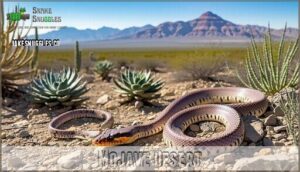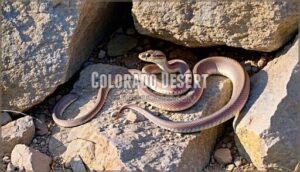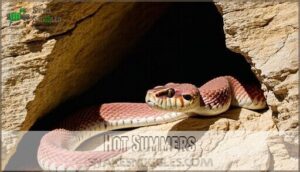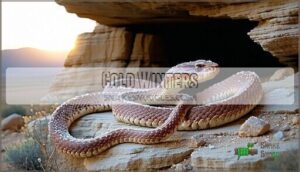This site is supported by our readers. We may earn a commission, at no cost to you, if you purchase through links.

Their rosy boa natural habitat includes rocky outcroppings, granite formations, and volcanic terrain across the Mojave, Sonoran, and Colorado deserts.
These adaptable snakes seek shelter in rock crevices, caves, and occasional burrows when rocks aren’t available.
They’ve mastered desert living, tolerating extreme temperature swings from scorching summer days to freezing winter nights.
The rocky landscape provides perfect ambush spots for hunting small mammals and birds.
Different desert regions produce distinct color variations and patterns in these snakes, creating fascinating regional differences you won’t expect, due to their ability to thrive in various arid deserts and adapt to extreme temperature swings.
Table Of Contents
- Key Takeaways
- Rosy Boa Habitat Overview
- Geographic Distribution
- Climate Adaptation
- Shelter and Hunting
- Regional Variations
- Frequently Asked Questions (FAQs)
- What is the rosy boa native habitat?
- What is the natural habitat of a boa constrictor?
- What predators threaten rosy boas in wild?
- How do rosy boas find water sources?
- Do rosy boas migrate seasonally between habitats?
- What vegetation grows in rosy boa territories?
- How does urbanization affect rosy boa populations?
- Conclusion
Key Takeaways
- You’ll find rosy boas thriving in three major desert ecosystems – the Mojave, Sonoran, and Colorado deserts – where they’ve adapted to extreme temperature swings from over 100°F to below freezing.
- You’ll discover these snakes rely heavily on rocky terrain like granite outcroppings and boulder fields, which provide essential shelter in crevices and perfect ambush spots for hunting small mammals.
- You’ll notice distinct regional color variations across their range, with each locale producing unique patterns and morphs that help identify where specific populations originated.
- You’ll see these desert specialists have mastered water conservation by getting most moisture from their prey rather than drinking directly, making them perfectly suited for arid southwestern conditions.
Rosy Boa Habitat Overview
You’ll discover rosy boas thriving in the harsh desert ecosystems of the southwestern United States and northern Mexico, where they’ve adapted to extreme temperatures and limited water sources.
These remarkable snakes make their homes in rocky, arid regions where granite outcroppings and boulder fields provide essential shelter and hunting opportunities.
Desert Ecosystems
You’ll find rosy boa habitat thriving within three major desert ecosystems of the southwestern US.
These desert snake environments showcase remarkable desert biodiversity despite water scarcity challenges.
Conservation efforts focus on protecting these fragile systems from desertification risks and human impact.
Key desert ecosystems include:
- Mojave Desert – Hot, dry summers with granite outcroppings
- Sonoran Desert – Diverse vegetation with rocky hillsides
- Colorado Desert – Sandy washes and boulder fields
Arid Regions
You’ll discover rosy boa habitat thrives in arid regions where water scarcity shapes every living thing.
These desert snake environments experience extreme temperature swings and minimal rainfall. Southwestern US arid biodiversity depends on specialized adaptations.
Desert ecosystems here feature unique soil composition that supports limited vegetation. Rosy boas excel in these harsh conditions, using conservation efforts to protect their diminishing territories from desertification impact.
Rocky Areas
Rocky areas provide Lichanura trivirgata with perfect hunting and shelter opportunities.
You’ll find these snakes thriving among granite outcroppings and talus slopes, where rock composition creates ideal crevice sizes for hiding.
South-facing rocky outcrops offer excellent basking spots, allowing temperature regulation throughout the day.
These rocky areas within desert habitats provide essential cover from predators and extreme weather conditions, making them ideal for temperature regulation.
Southwestern United States
You’ll discover rosy boas thriving across the southwestern United States, where these remarkable serpents have adapted to harsh desert conditions over thousands of years.
Their range spans southern California, Arizona, Nevada, establishing diverse populations in distinct desert ecosystems.
Thermoregulation strategies are essential for their survival in these extreme environments.
- Home territory stretches from California’s coastal ranges to Arizona’s Sonoran Desert
- Habitat loss threatens traditional rosy boa habitat through ongoing urbanization impact
- Conservation efforts focus on protecting remaining arid regions and rocky outcrops from future threats
Northern Mexico
Beyond the southwestern United States, you’ll encounter rosy boa habitat extending into northern Mexico’s arid landscapes.
Baja California and Sonoran distribution patterns create distinct Mexican subspecies with unique characteristics.
These Baja populations face increasing habitat threats from development and climate change, affecting their conservation status throughout Mexico’s desert regions.
| Region | Primary Habitat | Conservation Concerns |
|---|---|---|
| Baja California | Coastal scrublands, granite outcrops | Urban development pressure |
| Sonora | Desert valleys, rocky hillsides | Mining activities, road construction |
| Border Areas | Shared ecosystems with US populations | Cross-border habitat fragmentation |
Geographic Distribution
You’ll find rosy boas across three major desert regions in the American Southwest and northwestern Mexico.
Their range spans from the Mojave and Sonoran deserts to the Colorado Desert and coastal foothills of California and Baja California.
Mojave Desert
The Mojave Climate spans California, Nevada, and Arizona, creating perfect rosy boa habitat across southwestern United States.
You’ll find these desert-dwelling serpents thriving in scrublands where summer temperatures exceed 100°F and winters drop below freezing.
Desert Flora provides cover while rocky terrain offers shelter, and Prey Abundance peaks near water sources.
The rosy boa, or Lichanura trivirgata, is one of the four boa species native to the continental U.S., though Human Impact and Conservation Status require ongoing monitoring throughout this vast region.
Sonoran Desert
You’ll find Desert Rosy Boas thriving throughout Arizona’s Sonoran desert regions, where they’ve developed Unique Adaptations to handle the bimodal rainfall pattern.
The Sonoran Climate supports diverse Regional Prey like pack rats and kangaroo rats.
These southwestern USA populations show remarkable color variations, with earth-toned morphs providing perfect camouflage.
Their boa natural environment spans rocky foothills to flat bajadas, demonstrating excellent Conservation Status through adaptable shelter use in Sonora’s varied terrain.
Rosy Boas are considered ovoviparous species, giving birth to live young, and are found in the Sonoran desert with bimodal rainfall pattern.
Colorado Desert
The Colorado Desert’s low elevation creates unique desert microclimates where you’ll find rosy boa habitat thriving despite harsh conditions.
This desert region experiences extreme temperature variations that challenge snake habitat survival.
Key Colorado Desert features for rosy boas include:
- Rocky shelter sites – Granite outcroppings and boulder piles provide essential crevices
- Prey availability – Small rodents inhabit creosote bush scrub areas
- Thermal regulation – Stone cover offers temperature control during 120°F summers
- Water proximity – Colorado River corridor supports isolated populations
Human impact and habitat fragmentation increasingly threaten these desert-dwelling snake populations throughout desert regions.
Coastal Foothills
Coastal foothills provide unique rosy boa habitat where desert scrublands meet marine influences.
These rocky areas feature coastal sand dunes and specialized vegetation that creates distinct coastal microclimates.
You’ll discover vegetation impact substantially affects local snake populations, while human encroachment threatens traditional territories.
Wildfire effects alter landscape dramatically, making conservation efforts essential for protecting these transitional zones where rosy boas adapt to cooler, more humid conditions than interior desert populations, and face human encroachment and wildfire effects.
Climate Adaptation
You’ll find rosy boas are remarkably tough in regard to handling extreme temperature swings in their desert homes.
These adaptable snakes can tolerate scorching summer heat exceeding 100°F and winter temperatures that drop below freezing, making them true desert survivors.
Hot Summers
Desert Heat in the southwestern United States pushes rosy boa habitat temperatures beyond 100°F during summer months.
Your desert-dwelling snake shows remarkable Heat Tolerance through specific adaptations. These snakes reduce Summer Activity during peak heat, seeking rocky crevices for thermal refuge. Their Hydration Needs increase substantially, though they rarely drink directly.
Summer survival strategies include:
- Reduced daytime movement – staying hidden in cool rock crevices
- Increased nocturnal hunting – becoming more active after sunset
- Metabolic slowdown – entering partial Aestivation Period during extreme heat
- Behavioral thermoregulation – moving between sun and shade as needed
- Water conservation – obtaining moisture primarily from prey rather than drinking
Cold Winters
Desert-dwelling rosy boas face harsh Cold Survival challenges during southwestern United States and Mexico winters.
These resilient serpents enter Winter Brumation, a hibernation-like state where they retreat to rocky crevices and underground burrows.
Their Hibernation Habits include seeking frost-protected Winter Shelter locations. Unlike true hibernation, brumation allows occasional movement during warmer winter days, showcasing remarkable Frost Tolerance adaptations.
Temperature Tolerance
You’ll find these desert-dwelling snakes remarkably adaptable to extreme temperature swings.
Rosy boa habitat experiences scorching days exceeding 100°F and freezing nights below 40°F.
Their cold tolerance allows survival in temperatures as low as 35°F, while heat stress occurs above 95°F.
The ideal range sits between 75-90°F, where they maintain normal basking behavior and create natural thermal gradients for thermoregulation.
Alpine snakes also show genetic diversity to thrive in cold environments.
Humidity Levels
You’ll find rosy boa habitat naturally maintains low humidity levels, typically ranging from 30-50% relative humidity.
These desert dwellers have adapted to arid conditions where excessive moisture can cause respiratory health problems and interfere with proper shedding humidity requirements.
- Natural humidity stays below 60% in southwestern desert regions where rosy boas thrive
- Summer levels drop to 5-15% during peak heat, requiring careful enclosure misting management
- Measuring humidity accurately prevents respiratory infections common in overly moist environments
- Hydration needs are met through water access rather than high ambient moisture
- Snake humidity requirements include humid hides for shedding while maintaining dry overall conditions
Shelter and Hunting
You’ll find rosy boas tucked away in rocky crevices, caves, and granite outcroppings where they can ambush unsuspecting prey.
These natural hideouts provide both protection from predators and perfect hunting spots for catching rodents and small reptiles, which can be considered their prey.
Crevices and Caves
Through narrow gaps between granite boulders, you’ll find rosy boas maximizing crevice security for thermal regulation and predator avoidance.
These desert-dwelling reptiles exploit cave microclimates within rocky terrain, where stable temperatures and humidity create ideal natural habitat conditions.
Their habitat fidelity to specific crevices provides consistent shelter from extreme desert conditions and hunting opportunities.
Many owners also provide artificial rosy boa caves for their pets, utilizing artificial environments to mimic natural conditions.
Rock Cover
Looking at granite outcroppings and talus slopes, you’ll find rock density creates perfect microhabitats for desert-dwelling rosy boas.
These natural formations provide essential thermal properties that regulate body temperature throughout extreme weather cycles.
Key rock cover benefits include:
- Thermal regulation – rocks absorb heat during day, release warmth at night
- Protection zones – dense rock formations shield from predators and harsh winds
- Hunting advantages – crevices between rocks create ambush points for prey
This reptile habitat arrangement makes rock cover indispensable for survival.
These hides offer essential stress reduction.
Hiding Spots
Underground burrows and rock crevices provide essential security for rosy boas in their desert habitat.
These reptiles squeeze into narrow spaces between granite outcroppings, finding protection from predators and temperature extremes.
Vegetation cover around hiding spots offers additional camouflage and humidity control.
Rosy boas may also benefit from a simulated reptile habitat.
Desert-dwelling rosy boas depend on these secure retreats for survival in their natural habitat.
Ambush Predation
Positioning themselves strategically within rocky crevices, rosy boas become masters of ambush predation.
These hunting techniques rely on patience and precise strike speed when small mammals venture nearby.
Their sensory cues detect vibrations and heat signatures, triggering lightning-fast strikes.
Once prey is captured, the snake diet begins its digestion process, with prey selection typically focusing on appropriately-sized rodents that match their hunting strategies as effective ambush predators.
Regional Variations
You’ll notice that rosy boas from different regions show distinct color patterns that help identify their origin.
These locale-specific variations range from the deep red stripes of coastal populations to the muted grays and browns found in desert mountain ranges, which are distinct and locale-specific.
Color Morphs
Rosy Boas showcase fascinating genetic morphs through captive breeding programs. You’ll discover striking albino morphs lacking dark pigments, anerythristic types without red coloration, snow variations combining both traits, and hypomelanistic traits reducing black pigmentation.
These captive-bred genetic morphs create stunning visual diversity beyond wild populations. Some enthusiasts also seek specialized care products for these unique morphs.
- Albino morphs display bright yellow and orange stripes without black pigmentation
- Anerythristic types show gray and black patterns with eliminated red tones
- Snow variations combine albino and anerythristic genes for pale, ethereal appearances
- Hypomelanistic traits reduce melanin production, creating lighter overall coloration
- Designer morphs result from selective captive breeding for unique genetic combinations
Pattern Variations
Beyond their distinctive stripes, rosy boas display remarkable pattern variations across their range.
You’ll notice stripe aberrations creating unique designs, while blotched patterns replace traditional stripes in some populations.
Color intensity varies dramatically between regions, with pattern fading occurring as snakes age.
Scale irregularities add individual character to each specimen.
| Pattern Type | Geographic Region |
|---|---|
| Stripe Aberrations | California coastal areas |
| Blotched Patterns | Arizona desert populations |
| Color Intensity Variations | Nevada mountain regions |
| Pattern Fading Examples | Mexico borderland specimens |
Locale-Specific Traits
Each locale’s unique features help you identify where specific Rosy Boas originated.
Regional coloration varies dramatically across California, Arizona, Nevada, and Mexico populations. Scale patterns reflect local environments, while size differences emerge between desert and coastal groups.
- Regional coloration ranges from bright orange stripes in Morongo Valley to deep brown patterns in Maricopa Mountains
- Scale patterns match local substrates, with granite-dwelling snakes showing gray tones for camouflage
- Size differences occur between populations, with some Southern California specimens exceeding 40 inches
- Genetic diversity creates locale-specific morphs rarely found outside their native regions
Subspecies Identification
Identifying subspecies requires examining multiple characteristics beyond simple locale colors.
You’ll need to analyze stripe patterns, scale counts, and genetic markers for accurate classification.
Hybrid zones between California and northern Mexico create identification challenges for Lichanura trivirgata populations.
| Identification Method | Key Features |
|---|---|
| Visual Assessment | Stripe clarity, color intensity, pattern consistency |
| Scientific Analysis | DNA testing, scale counts, morphometric measurements |
| Geographic Origin | Collection locality, habitat type, elevation data |
Regional variations often overlap, making field identification tricky without laboratory confirmation.
Frequently Asked Questions (FAQs)
What is the rosy boa native habitat?
You’ll find these hardy serpents thriving in southwestern United States and northwestern Mexico’s arid landscapes. They prefer rocky desert scrublands, granite outcroppings, and boulder-strewn hillsides where crevices provide perfect shelter.
What is the natural habitat of a boa constrictor?
You’ll find boa constrictors thriving from northern Mexico through Argentina in diverse habitats. They live in tropical rainforests, savannas, woodlands, semi-deserts, and areas near water, preferring humid rainforest conditions.
What predators threaten rosy boas in wild?
Nearly 80% of rosy boas face year-round threats from predators. You’ll find coyotes, raccoons, skunks, weasels, hawks, shrikes, and kingsnakes hunting these vulnerable desert dwellers.
How do rosy boas find water sources?
Water sources remain elusive for you in the desert, so rosy boas obtain moisture primarily from their prey.
During dry periods they burrow underground to stay hydrated, emerging only when rainfall provides temporary surface moisture.
Do rosy boas migrate seasonally between habitats?
Like tumbleweeds blown by desert winds, you won’t see rosy boas making seasonal migrations.
They’re homebodies that stick close to their rocky hideouts year-round, simply moving between nearby crevices as temperatures change throughout the seasons, which makes them stay in their preferred hideouts.
What vegetation grows in rosy boa territories?
You’ll discover vegetation in rosy boa territories includes desert shrubs, cacti, creosote bushes, and scrub plants.
These snakes inhabit dry shrublands, desert areas with scattered rocks, and rocky deserts throughout arid southwestern regions.
How does urbanization affect rosy boa populations?
Urbanization greatly threatens you’ll find rosy boas struggling with habitat fragmentation, road mortality, and development pressure, forcing these desert specialists to compete for shrinking rocky refuges.
Conclusion
Knowledge is power in understanding the rosy boa natural habitat.
These remarkable snakes have mastered desert survival across three major ecosystems in the southwestern United States and northern Mexico.
Their rocky desert homes provide essential shelter and hunting grounds while extreme temperature variations shape their behavior.
Each region produces distinct color patterns and physical traits, making location identification possible through careful observation.
Understanding their habitat requirements helps you appreciate these adaptable desert specialists.
- https://www.zillarules.com/information/care-sheets/rosy-boa
- https://www.reddit.com/r/rosyboas/comments/17nr1lm/doing_some_research_before_purchasing_a_rosy_boa/
- https://www.meskerparkzoo.com/wp-content/uploads/2021/10/Rosy-Boa.pdf
- https://www.lapetfair.com/the-ultimate-guide-to-rosy-boa-care-everything-you-need-to-know/
- https://animaldiversity.org/accounts/Charina_trivirgata/
















